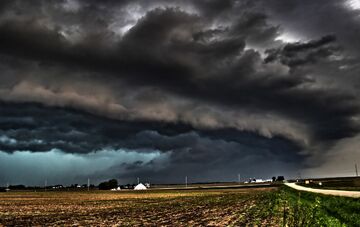No edit summary Tag: sourceedit |
(Added a Lligariphobia reference, as some Tempestaphobia sufferers may panic when loud alarms such as Weather Radios or Tornado Sirens sound.) Tags: Visual edit apiedit |
||
| Line 6: | Line 6: | ||
Tempestaphobia can be treated using {{wp|cognitive-behavioral therapy}} (CBT). |
Tempestaphobia can be treated using {{wp|cognitive-behavioral therapy}} (CBT). |
||
| + | |||
| + | If the sufferer fears other loud noises outside of storms, such as Tornado Sirens, or Weather Radio Alarms, this may aggravate their fear, and may cause the sufferer to panic. If the sufferer fears the alarms in general, the sufferer may have [http://psychology.wikia.com/wiki/Ligyrophobia Ligyrophobia], or the fear of irrational loud noises. |
||
{{Weather phobias}} |
{{Weather phobias}} |
||
Revision as of 00:35, 5 September 2017
← Back to: List of phobias

Tempestaphobia (from the Latin word tempestas, meaning "storm", and Greek phobos, "fear") is the irrational fear of storms. The most common branch is ceraunophobia (fear of thunder and lightning), followed by turbophobia (fear of tornadoes). For those living in places like the Midwest, they may fear thunderstorms and tornadoes during the warmer parts of the year, and during the wintertime they may fear blizzards (see chionothyellaphobia). For those living near the coasts, they may fear tropical cyclones (such as hurricanes) approaching.
Sufferers would be obsessed with the weather and feel worry about their lives and their property. They would tune to the Weather Channel or use a weather app or website to get updates if storms are heading their way. Many would only go outside or to outplaces if skies are clear with no storms approaching. If a storm approaches, one would take cover in a small interior room, such as a closet, while others may hide under the bed or table. If the storm is getting violent, many would ride out in their basement or storm shelter if they have one (they must take shelter in the safest place if tornado approaches).
Tempestaphobia can be treated using cognitive-behavioral therapy (CBT).
If the sufferer fears other loud noises outside of storms, such as Tornado Sirens, or Weather Radio Alarms, this may aggravate their fear, and may cause the sufferer to panic. If the sufferer fears the alarms in general, the sufferer may have Ligyrophobia, or the fear of irrational loud noises.
| Weather phobias |
|---|
| Aestophobia (fear of hot weather) · Agripyrophobia (fear of wildfires) · Anemophobia (fear of winds) · Antlophobia (fear of flooding) · Ariditaphobia (fear of droughts) · Catastrophobia (fear of any natural disaster) · Ceraunophobia (fear of thunder and lightning) · Chionophobia (fear of snow) · Chionothyellaphobia (fear of blizzards) · Cyclonophobia (fear of tropical cyclones) · Cymophobia (fear of waves) · Frigoriphobia (fear of cold weather) · Grandophobia (fear of hail) · Homichlophobia (fear of fog) · Humidophobia (fear of humidity) · Nephophobia (fear of clouds) · Nivisphobia (fear of avalanches) · Ombrophobia (fear of rain) · Pluvifrigophobia (fear of freezing rain) · Tempestaphobia (fear of storms) · Serenophobia (fear of fair weather) · Turbophobia (fear of tornadoes) |